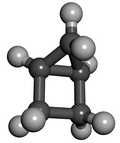房烷
外觀
| 房烷 | |||
|---|---|---|---|
| |||
| IUPAC名 Bicyclo[2.1.0]pentane | |||
| 別名 | 雙環[2.1.0]戊烷 | ||
| 識別 | |||
| CAS號 | 185-94-4 | ||
| PubChem | 9101 | ||
| ChemSpider | 8747 | ||
| SMILES |
| ||
| InChI |
| ||
| InChIKey | MHLPKAGDPWUOOT-UHFFFAOYAN | ||
| 性質 | |||
| 化學式 | C5H8 | ||
| 摩爾質量 | 68.12 g·mol−1 | ||
| 外觀 | 無色液體 | ||
| 沸點 | 45.5 °C[1] | ||
| 若非註明,所有數據均出自標準狀態(25 ℃,100 kPa)下。 | |||
房烷(英語:Housane)是一種飽和的雙環烷烴,化學式為C5H8。在室溫下為無色揮發性液體。它的名字「房烷」來源於像房子的形狀。在結構上,該分子由與環丁烷稠合的環丙烷組成。
製備
[編輯]房烷可以由2,3-二氮雙環[2.2.1]庚-2-烯的熱分解而成。這個方法是魯道夫·克里奇在1957年發表的。[2][3]

它也可以由2,3-二氮雙環[2.2.1]庚-2-烯的光分解,N-苯基-2-氧-3-氮雙環[2.2.1]庚烷的熱分解或是甲烯加成到環丁烯而成。[4][5][6][7]
性質
[編輯]房烷很容易被溴或碘攻擊。在鉑催化劑下,房烷在室溫下就會被氫化成環戊烷。它和溴化氫在低溫下反應產生的是溴代環戊烷。房烷和四乙酸鉛反應則生成cis-1,3-二(乙酰氧基)環戊烷。[2]

房烷對熱穩定,330 °C才異構化成環戊烯。[2](Rh(CO)2Cl)2可以催化房烷異構化成環戊烯的反應,室溫下的反應半衰期為8小時。[8]
另見
[編輯]參考資料
[編輯]- ^ P. G. Gassman, K. T. Mansfield, Bicyclo[2.1.0]pentane, Organic Syntheses 49, 1969, 49: 1, doi:10.15227/orgsyn.049.0001
- ^ 2.0 2.1 2.2 Rudolf Criegee, Annemarie Rimmelin, Darstellung und Eigenschaften von Bicyclo-[0.1.2]-Pentan, Chemische Berichte 90 (3), 1957, 90 (3): 414–417, doi:10.1002/cber.19570900319
- ^ Saul G. Cohen, Robert Zand, Colin Steel, Preparation and Kinetics of Decomposition of a Bicyclic Azo Compound. A Novel Reduction1, Journal of the American Chemical Society 83 (13), 1961, 83 (13): 2895, doi:10.1021/ja01474a025
- ^ Colin Steel, Photolysis of Bicyclic Aza Compounds. I. 2,3-Diazabicyclo[2.2.1]2-heptene, The Journal of Physical Chemistry 67 (9), 1963, 67 (9): 1779–1781, doi:10.1021/j100803a008
- ^ Timothy F. Thomas, Colin Steel, Photoinitiation of Unimolecular Reactions. The Photolysis of 2,3-Diazabicyclo[2.2.1]hept-2-ene, Journal of the American Chemical Society 87 (23), 1965, 87 (23): 5290, doi:10.1021/ja00951a005
- ^ C. E. Griffin, N. F. Hepfinger, B. L. Shapiro, The Pyrolysis of 2-Phenyltetrahydro-1,2-oxazines as a Simple Preparative Entry to Cyclobutanes, Journal of the American Chemical Society 85 (17), 1963, 85 (17): 2683, doi:10.1021/ja00900a049
- ^ Georg Wittig, Frank Wingler, Über methylenierte Metallhalogenide, IV. Cyclopropan-Bildung aus Olefinen mit Bis-halogenmethyl-zink, Chemische Berichte 97 (8), 1964-08, 97 (8): 2146, doi:10.1002/cber.19640970808
- ^ Gassman, Paul; Atkins, Thomas; Lumb, J. Transition Metal Complex Promoted Rearrangements. Bicyclo[2.1.0]pentane and 1-Carbomethoxybicyclo[2.1.0]pentane. Journal of the American Chemical Society (American Chemical Society (ACS)). 1972, 94 (22): 7757–7761. ISSN 0002-7863. doi:10.1021/ja00777a604.


